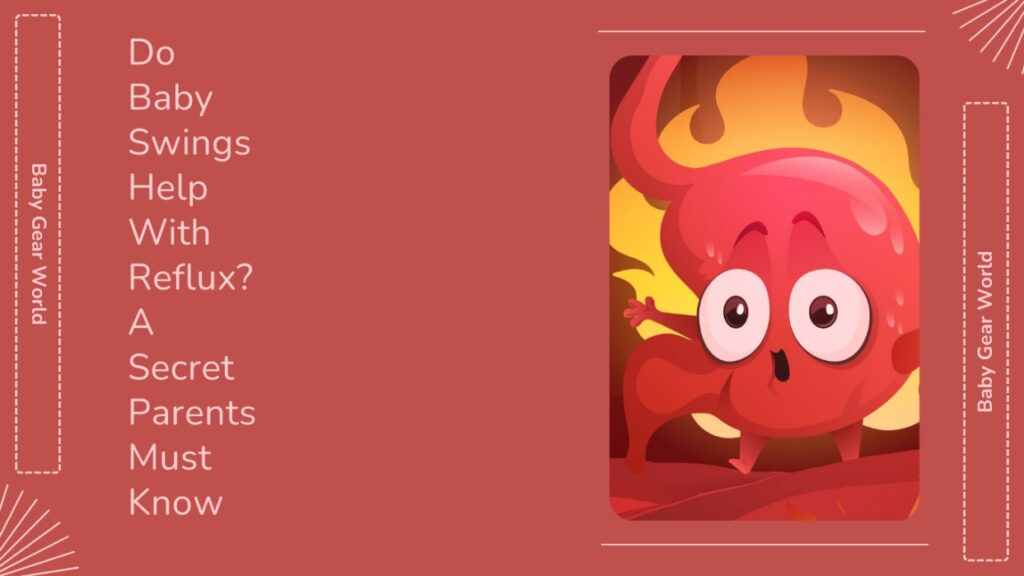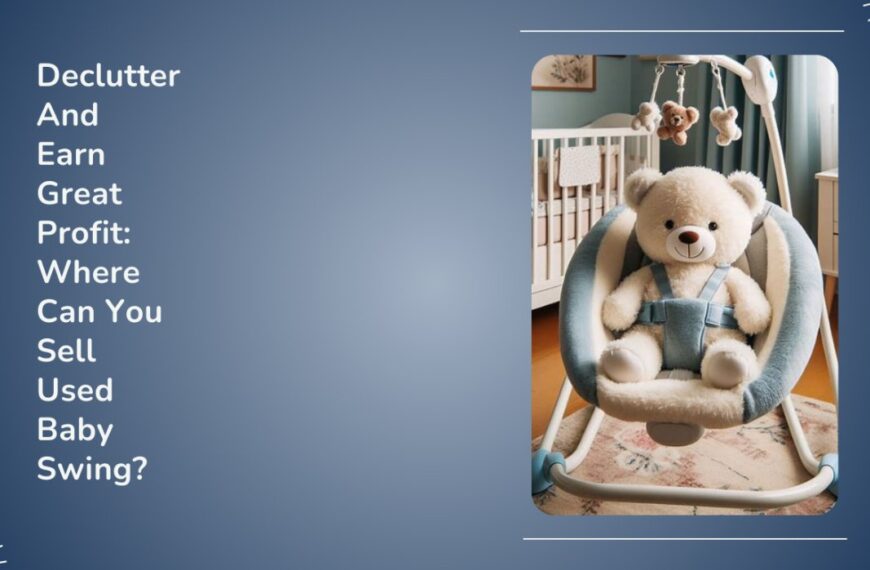Do you have a baby who suffers from reflux that makes them spit up, cry, and feel uncomfortable?
We know how frustrating and painful it can be for both of you.
But here’s some good news – most babies stop having this problem when they’re 12 to 14 months old.
During this challenging time, parents often search for something that can give their little ones some relief.
Many new parents think that a baby swing might be the answer.
We’ll find out that in this blog post, and we will also explore these topics:
- What is reflux?
- What is the difference between GER and GERD?
- What is the root cause of reflux?
- Symptoms of Reflux
- Do baby swings help with reflux?
- What are the safety considerations of baby swings for reflux?
- Other Remedies for Reflux?
People Also Read: Does Baby Swing Help with Gas?
Table of Contents
What is Reflux?
Reflux (also named Gastroesophageal Reflux (GER)) is a condition in which the food in baby’s stomach flows back up to the throat, causing irritation and discomfort for the little one.
It is so common that over 34,000 babies in Australia suffer from reflux disease every year.
But you don’t have to be too scared because reflux usually goes away as your baby gets older and their stomach strengthens.
Difference between GER and GERD
GER stands for Gastroesophageal Reflux.
It is the usual reflux that we discussed above and is very common in babies.
It is not a very serious issue because its intensity decreases as the baby grows, and by the age of 1 year (or sometimes 1.5 years), the baby outgrows this problem.
Gastroesophageal Reflux Disease (GERD) is a condition where this usual reflux happens a lot and causes serious problems like severe pain, discomfort, or trouble eating.
It’s like GER but more severe and can affect older kids and adults.
So, in simple terms, GER is the usual reflux many babies have, while GERD is a bigger issue that needs more attention from doctors and proper medical treatment.
In this blog post, our primary focus will be on the Gastroesophageal Reflux (GER) that is more common in babies.
What is the root cause of reflux in babies?
Babies are still growing, and their bodies are still learning how to do things.
One thing that their body is learning is how to keep the food and drink in their stomach.
The stomach and the throat have a tube between them called the Esophagus.
Sometimes, this tube doesn’t work perfectly in babies.
The ring-like muscle at the end of this tube, which stops the food and drink from coming back up, might not be fully developed in babies.
So, when the stomach is full, some of that food can come back up to their throat.
Babies often lie down and only take liquid food like milk, which can come up more easily than solid food.
It’s all part of growing up, and most of the time, babies stop having this problem as they grow, and these parts of their bodies get better at doing their jobs.
Symptoms of Reflux
If you find these symptoms in your babies, they might be facing reflux issues:
- Frequent spitting up, often after feeding
- Irritability and fussiness, especially when lying down or after meals
- Arching of the back or frequent squirming
- Pulls their legs up while excessively crying
- Poor weight gain or difficulty in gaining weight
- Constant Hiccups after feeding
- Trouble sleeping
- Occasional coughing fits
Remember that not all babies with reflux will experience all of these symptoms.
It’s always a good idea to consult with a pediatrician if you see these symptoms in your babies.
Do baby swings help with reflux?
Now, let’s get to the important question: Do baby swings help with reflux?
There are a few reasons why they might help, but it is a temporary solution to lessen the baby’s fussiness and not a cure for reflux.
Let’s look at how baby swings can help:
Upright Position
One of the ways that baby swings can help with reflux is by holding the baby in a more upright position.
When babies are in an upright position, it’s less likely for stomach food to go up into their throats.
According to some experts, the ideal angle for a baby with reflux is between 30 and 45 degrees.
Most baby swings have adjustable recline options that allow you to find the best angle for your baby.
Soothing Motions
Another way that baby swings can help with reflux is by providing soothing motions that can reduce discomfort and crying.
Many parents find that rocking, bouncing, and swaying babies can calm them down and ease their pain.
Baby swings have different types of motions, such as front-to-back, side-to-side, or circular and have many speed variations that allow you to customize the swing to your baby’s preference.
You can experiment with these different motions and speed levels to find out what works for your baby and makes him comfortable.
Also, baby swings often move back and forth or side to side in a gentle, soothing way.
This motion can make your baby feel relaxed and less fussy, which is good news for parents dealing with a reflux baby.
Melodies and Nature Sounds
Baby swings can distract babies from reflux irritation by playing music or sounds or having toys attached to the swing.
Some babies may find music or sounds soothing and relaxing, while others may find them stimulating and engaging.
In both cases, these features distract from the tummy troubles your baby might be experiencing.
All these features of a baby swing work together and can provide much-needed relief for the baby.
By keeping him in an upright position, providing comfort through different soothing motions and speed levels, and distracting the baby’s attention from reflux irritation with the help of melodies, nature sounds and engaging toy bars.
Safety Considerations for the Baby Swings
Parents should strictly follow some safety considerations for their baby’s safety when using baby swings for reflux.
Here are some of them:
Usage Time Limit
Baby swings should not be used for more than 30 minutes at a time and no more than twice a day.
Using baby swings for too long can cause the baby to develop a flat head syndrome.
A condition where the back or side of the head becomes flattened due to prolonged pressure.
Not a Substitute for Burping and Proper Medication
Baby swings should not be used as a substitute for burping and medication (if prescribed) for reflux.
Feeding the baby smaller and more frequent meals, burping them after each feed, and giving them medication as directed by the doctor can help prevent or reduce reflux episodes.
Baby swings should only be used as a tool to comfort the baby after following these routines.
Don’t Use Swings for Sleeping Purposes
Baby swings are not designed to provide a safe and comfortable sleeping surface for the baby, as they can cause the baby’s head to fall forward or backward, obstructing the baby’s airway.
Therefore, parents should always move the baby to a crib or bassinet when they fall asleep in a swing.
Other Remedies for Reflux?
There are other remedies and strategies you can try to handle this reflux issue in your babies besides using a baby swing:
Feeding Techniques
Adjust the way you feed your baby. Try smaller, more frequent feedings to prevent the stomach from getting too full.
Keep your baby upright during and after feeds for about 30 minutes.
Burping
Burp your baby during and after feeding.
Burping can help release the air trapped in the stomach and prevent the food or liquid from coming back up.
You can burp your baby by holding them upright on your shoulder or lap and gently patting their back.
Changing Your Baby’s Sleeping Position
You can elevate the head of your baby’s crib or bassinet by placing a firm pillow or a folded towel under the mattress.
This can help gravity keep the food or liquid in the stomach and reduce reflux.
You should always put your baby to sleep on their back, not on their stomach or side.
Give Less But More Frequent Feeds
Give your baby smaller and more frequent feeds.
This can prevent overfilling the stomach and reduce the pressure that causes reflux.
You can also avoid feeding your baby right before bedtime or naptime, which can worsen reflux.
Thicker Feeds
You should only do this if advised by your doctor or health advisor.
If the baby is facing a reflux problem, some doctors suggest parents use special reflux formulas or add rice cereal to the baby’s formula to thicken it slightly.
This can make it harder for the milk to come back up.
Final Words
To sum it up, baby swings can be a valuable tool for soothing reflux-related discomfort and fussiness in infants.
Their upright position and gentle rocking motions with melodies can provide comfort to your baby.
However, we should keep in mind that every little one is different, and it may not work for every baby.
Usually, babies get out of this reflux problem as they grow and their digestive systems become strong.
However, it’s essential to remember that baby swings do not replace a doctor’s medical advice.
So, if your baby has severe or persistent reflux, it’s crucial to consult with a healthcare professional for guidance and proper medical treatment.
Related Blog Posts





